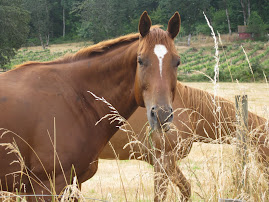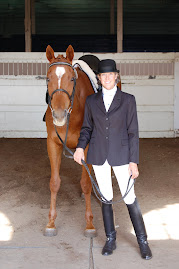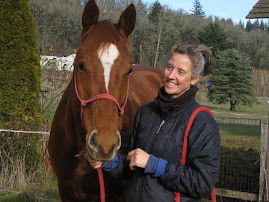In my last post, I talked about that overused word:
Collection.
I gave the United States Dressage Federation's (USDF) definition of:
Collection
Working (trot/canter)
Uphill
Then I began thinking about Flexion.
Flexion (also called Bending) in a horse is when a body part "flexes" due to some form of pressure.
Pressure to create Flexion is generally direct by using a hand, leg, heel, spur, bit, or whip directly on the body of the horse. For example: I put pressure on the bit from the left rein and the horse's mouth and nose bend in to the left and the jaw, poll and neck Flex to the right.
The amount of pressure needed to create the flexion should depend certain factors, such as, rider skill and the horse's level of training. Technically, the more skill the rider has, the lighter the pressure. And technically, the higher level of training the horse has, the lighter the response.
Lateral as defined by the USDF is:
To the side, as in flexion, bend, suppleness, or direction of movement. Impurity in the walk (ambling or pacing) or canter; rarely in trot.
Examples of Lateral Flexion are: bending at the poll, bending in the ribcage, side pass, leg yield, half pass.
When a horse flexes correctly, it creates a softness in the equine that is efficient and functional. This then creates movements that look effortless and easy for both horse and rider. It's beautiful.
However, there is an aspect on Flexion that is rarely discussed:
Vertical Flexion/Lift.
I looked again in the USDF definitions and did not find Vertical Flexion.
In the previously blog about Collection, I mentioned the concept "Uphill." Uphill was the closest definition I could find to Vertical Flexion...
My definition of Vertical Flexion is:
The creation of Lift or Elevation in the horse's body where there is contraction of the horse's stomach muscles, which lifts the back, and at the same time, lowering the hindquarters. These actions elevate and lighten the front end, giving the horse the appearance of being "Uphill."
To have CORRECT Collection, both Lateral Flexion and Vertical Flexion is required...
Which is why true Collection takes years to develop. It begins with Lateral Flexion. Teaching horse & rider to find the softness in each other through the practice of movements. Overtime, the softness becomes strong and supple, like a ballarina and her partner.
As the training continues, the movements toward true Collection become lighter and more contained as the element of Vertical Flexion is added to the established Lateral Flexion.
These two aspects of true Collection create a dance between horse & rider that is unsurpassed in it's refinement and beauty.




No comments:
Post a Comment